Multinoncentrosymmetric Two-Dimensional Trilayered Lead Bromide Perovskites with Methylhydrazinium Cations: Lattice Dynamics, Phase Transitions, Dielectric Response, and Optical Properties
Title: Multinoncentrosymmetric Two-Dimensional Trilayered Lead Bromide Perovskites with Methylhydrazinium Cations: Lattice Dynamics, Phase Transitions, Dielectric Response, and Optical Properties
Authors: M. Mączka, S. Smółka, D. Stefańska, A, Gągor, J.K. Zaręba, K. Fedoruk-Piskorska, M. Ptak, D. Drozdowski, A. Sieradzki
Journal: Chemistry of Materials
DOI: 10.1021/acs.chemmater.4c01174

In their recent article, prof. Mączka’s group reported studies of compounds belonging to family of multilayered Ruddlesden-Popper (RP) hybrid lead halide perovskites, which are emerging class of perovskites that exhibit exceptional electrical, and linear and nonlinear optical (NLO) properties. Due to these features, they show immense potential in energy conversion, energy storage, light emission and photodetector technologies. The research focused on the characterization of two perovskites comprising methylhydrazinium (MHy+) cation in the perovskite voids, and butylammonium (BA+) or iso-butylammonium (iBA+) as separators between perovskites layers.
It has been demonstrated that the iBA analogue features much more complex polymorphism than its BA counterpart and that all phases stable below 360 K are noncentrosymmetric. The studies also showed that these perovskites exhibit efficient thermochromic photoluminescence, both linear and nonlinear, and that the presence of phase transitions profoundly influences the structural, dielectric and NLO properties of these compounds.
It is worth to emphasize that electron-phonon coupling plays a very important role in the optoelectronic properties of lead halide perovskites since it affects the key parameters such as exciton binding energy and charge carrier transport. This work proved that Raman and IR methods provide valuable information on lattice dynamics, contribution of each cation (cage or interlayer) to the PT mechanism, distortion of the inorganic slabs, change in the hydrogen bond strength and number of crystallographically unique organic moieties, i.e. aspects that are often challenging to discern using other experimental techniques due to the inherent complexity of the multilayered RP perovskite structure. Thus, the study marked the first instance where Raman and IR spectroscopic techniques have been successfully employed to independently probe the dynamics of cage and interlayer cations within Ruddlesden-Popper perovskites, providing key information on the crystal structure and phase transition mechanisms of these complex materials as well as origin of polar order and NLO properties.
Highlights:
- Two quasi-2D halide perovskites have been synthesized
- Structural, optical and electrical properties have been described
- The molecular dynamics of organic cations has been described
- The origin of polar order has been explained
- The importance of multi-technique approach in studies of lead halides has been explained by analyzing advantages and drawbacks of various experimental methods
See also
- The Institute
- General information
- Employees
- News
- Scientific News
- Gender equality plan
- Address and contact data
- Research
- Research profile
- List of publications
- List of projects
- International cooperation
- Information in BIP
- Scientific Council
- Organizational structure
- GDPR


